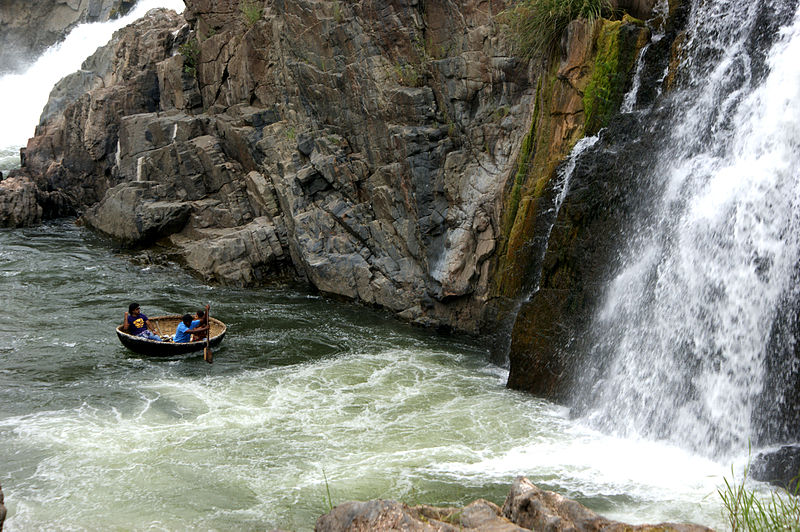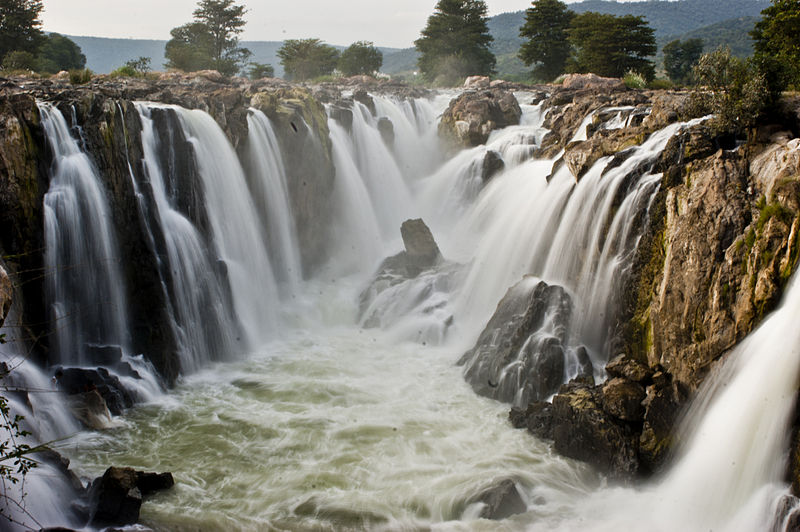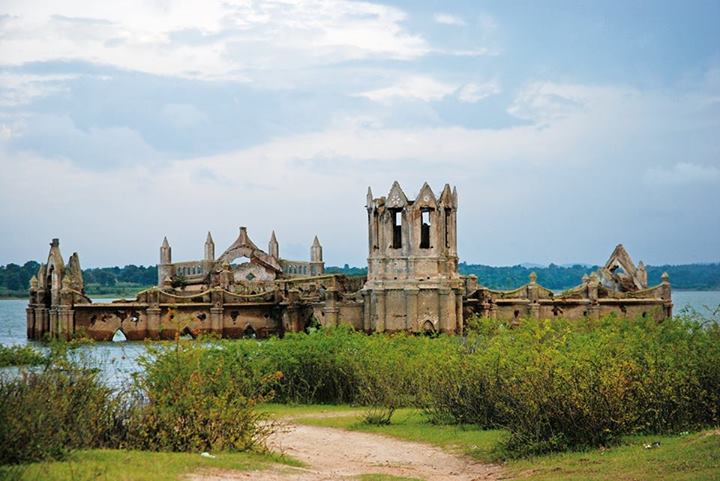Hogenakkal Falls: Coracle ride on the Kaveri
A mighty mass of water tumbling amidst rocky gorges, the stunning Hogenakkal Falls is a sight to behold.
From Bengaluru, Hogenakkal is a short, convenient distance away. We left at 6 am by our car. Taking NH 7, we reached Hosur in just 45 minutes. On our way, we had our breakfast at Reddy restaurant in a small town lying between Hosur and Denkanikotta.

Hogenakkal Falls (Photo by ezhuttukari)
We reached Hogenakkal in just four hours. As we had planned for a day trip, we did not take up accommodation anywhere. After parking our car safely, we headed towards the Boat Club. The coracles are boats made of a weed with some black coal tar like material in the bottom to prevent water from coming inside. For INR 110 per person, we got an hour-long ride on the river Kaveri. The ride will take you to the foot the majestic waterfalls – an exhilarating yet intimidating experience. The water here surges under the coracle, tossing it around, raging and hissing as though it might flood and capsize the boat any moment. This white waterfall is particularly impressive soon after the monsoon months when the river is brimming.
The sound of the Kaveri river, roaring between rocky banks, is a constant presence in most places in Hogenakkal. Here, the Kaveri flows through a wooded valley, splitting and merging and splitting again around rocks, and little islands with towering trees, and boulder- strewn out crops, which are covered only when the river is in spate with the rains of the monsoon.

Hogenakkal Falls (Photo by Ezhuttukari)
Another attraction is the diving skills of local kids, who can show their skills for a small fee of INR 5. They can dive for you from a height of around 30 feet into the water and climb straight up back on the rocks in no time. The spot is quite popular with tourists and locals, and there are plenty of vendors selling snacks and drinks. If you like fish, then you’ll enjoy the fresh catch being cooked by locals on the banks. You can also try getting a massage from the famed Hogenakkal masseurs. The local malishkarans or the mystic masseurs are armed with oils, powders and esoteric knowledge about the massage points in the human body. There are a few women masseurs too.
Getting there
By air: The nearest airport is Bengaluru, 150 km away. The Chennai airport is 350 km away.
By rail: The nearest railway station to Hogenakkal is Dharmapuri, about 40 km away.
By road: There are regular buses from the major cities of Karnakata and Tamil Nadu to Hogenakkal. The nearby cities include Coimbatore, Bengaluru, Salem and Morappur.
Where to stay
The best place to stay is the Tamil Nadu Tourism resort, 100 m away from the main location in Hogenakkal. They charge INR 700 for non-AC rooms and INR 900 for AC rooms. You can also choose from plenty of lodges and hotels.
Bengaluru to Hogenakkal
150 km
Melukote: The Temple Town
Melukote, nestled in the Sahyadri range near Mysore, is one of the most sacred places in Karnataka. Perched atop a rocky ridge in the Sahyadri ranges, the town of Melukote is famed for its temples, Iyengarpuliy- odarai (a tamarind rice dish) and the Academy of Sanskrit Research. The 12th century Cheluvarayaswami temple here flaunts a rose-coloured tower and lionheads facing the four directions.
Ramanuja, the Vaishnavite saint, is said to have recovered the lost idol of the main deity here. Hence, Ramanuja is worshipped along with Vishnu in the Narayana temple. Within walking distance of this temple is the massive Unfinished Gate with exquisite carvings of crouching figures, striding elephants, maidens and sculpted divinities.
Perched on the summit of a hill to the northeast of the town, is the small Yoganarasimha temple, overlooking the Kalyani Tank. It offers panoramic views of the surrounding hills and the lush Cauvery valley.

Melukote Temple (Photo by Mandayamr)
A not-to-be-missed heritage site is Dhanushkoti, a rock peak, where Ramais said to have shot an arrow that struck a spring of water that quenched Sita’s thirst. Pilgrims throng to Melukote to witness the spectacular Vairamudi festival, the temple’s annual extravaganza, when the processional deity is donned with the legendary diamond-studded crown and other jewels belonging to the former Maharajas of Mysore and paraded. These jewels, that remain in safe custody at the government treasury in Mandya, are brought out on this auspicious day under armed escort.
Enroute, one can stop by Tonnur or Kere Tonnur, a scenic hamlet dotted with the ancient temples. The lake here is a popular weekend getaway with boating facilities.
The Melukote Temple Wildlife Sanctuary houses wolves, jungle cats, leopards, bonnet macaques and pangolin, and is an ornithologist’s paradise, with around 200 species of birds indigenous to the area. A walk early in the morning in the surrounding areas will guarantee peacock sightings.
Getting there
Take the Srirangapatna-Pandavapura route to reach Melukote. If you’re travelling from Bengaluru, after Maddur, at the Mandya circle, take a right turn, and proceed another 30 km to reach Melukote.
Location: 50 km from
Mysore; 140 km from Bengaluru.
Where to stay
Lodging options are nil.
Where to eat
Small eating joints serve snacks and refreshments
Shettihalli: Beauty under water
Enjoy the scenic views of the partially submerged church and the backwaters of the Hemavathi river at Shettihalli.
Come monsoon, when the waters of the Hemavathi River rise to partially submerge the church in Shettihalli hamlet, it assumes the look of a stranded ship. The spire is visible at times. In summer, when the waters recede, the battered edifice provides a striking contrast to the breathtaking landscape. The solid ruins have withstood the havoc of several monsoons but eventually the roof has caved in. Despite being submerged, the columns, the arch, a few walls, part of the altar and the central nave are intact, but there are no stained glass windows, pews left. Only a few walls remain to tell a story. It is said that the church was built with mortar and a mixture of jaggery and eggs.

The Holy Rosary Church at Shettyhalli
Built in 1860 by French missionaries for the affluent British estate owners in the neighbouring areas, the prominent Holy Rosary Church on the fringes of the picturesque village of Shettihalli in Hassan district was attributed to Father Dubois. The church’s lower part which is under water was submerged for the first time 25 years ago when the Gorur dam, situated eight kilometers away from the church site, flooded the region during the monsoon. With the construction of the dam, the entire village had to evacuate. People moved on with their belongings and relocated upstream leaving behind the church.
Shettihalli’s backwaters continue to lure tourists with its spectacular sunset, excellent birding, angling and photo opportunities. The peaceful and pristine environs have formed the backdrop of many fight sequences, and romantic interludes of various movies. The backwaters also plays host to a multitude of aquatic birds and winged visitors. Subsequently a new church Japa Maleya Raniya Devalaya, was built on higher ground at Jyoti Magar, a part of Shettihalli village, using portions of the stained glass and other treasures salvaged from the original church.
Getting there
Shettihalli is13 km from Hassan. Just before the right turn for Belur, you’ll pass the College of Ayurveda and Nisarga College of Nursing on the main Hassan road. Look for the left turn to Shankaranahalli to reach Shettyhalli.
Where to stay
Hoysala Village Resort,
Belur Road, Hassan – 573 201
Tel: +91 8172256764
Hassan to Shettihali
13 km
Vedanthangal: A welcome hullabaloo
Black ibises, painted storks, grey pelicans, cormorants, darters, at Vedanthangal, you can see them all.
Guided by natural instincts and regulated by biological clocks, avians of all sizes and hues descend for their annual rendezvous in the serene setting of the marshy Vedanthangal Lake from October to March each year.
Tourists flock to the 74-acre bird sanctuary and the nearby Karikili Lake to feast their eyes on the winged visitors from far-flung regions. It is, incidentally, the oldest water-bird sanctuary in India and protected more by the villagers than by law. The Barringtonia mangroves in the sanctuary serve as a floating habitat for an impressive variety of migratory birds. As one follows the paved path, dotted with watchtowers and benches, one can hear raucous cries along with the bustle of nesting and feeding activities. The watchtower provides a good view of open-billed storks, grey herons, pond herons, night herons, black ibises, grey pelicans, darters, spoon bills, night herons, cormorants, grey ducks, teals, snake birds and painted storks snugly settling down on their nests to begin breeding with extraordinary clock-work precision.

Vedanthangal Lake (Photo by VinothChandar)
During the season atleast 18 species of migratory birds from all over the world can be spotted here. Black winged stilts, spotted billed or grey pelicans and coots are some of the indigenous birds visiting Vedanthangal for feeding. The population of the migratory birds swells to around 40,000 by mid-January. Over the years close to 115 species have been spotted at the lake.
The residents of Vedanthangal and the five other villages adjoining the sanctuary enjoy a unique symbiotic relationship with the migratory birds that flock to the sanctuary every year. Besides providing a visual treat to naturalists, the winged visitors play an important role in enriching the lake with all plant nutrients.
The villagers are aware of the inherent understanding of the relationship between the winged visitors and the productivity of their crops.
Getting there
By air: The nearest airport is located at Chennai, 85 km away.
By rail: Chinglepet, 45 km away, is the nearest railway head.
By road: The best option is to drive down from Chennai along NH-45.
Where to stay
Forest Department Rest House in Vedanthangal (+91-44-24321471).
Chennai to Vendanthangal
85 km
Gandikota: India’s Grand Canyon
Gandikota, popularly referred to as India’s Grand Canyon, is a beautiful gorge formed in between Erramala Hills in Andhra Pradesh. It was a vacation organised by one of the trip organisers in Hyderabad, and we were a group of eight strangers who enrolled for this trip. We were to live in tents in a remote area and had to plan well in advance for food, energy drinks, water, and other necessary items. If you are adventurous enough to stay in a tent, there is no better experience than this.
How to reach Gandikota
We took off from Hyderabad MG Bus Stand on a Friday. After a journey of seven hours, we reached Jammalamadugu, the nearest bus stop from Gandikota. From here, we boarded autorickshaws for Gandikota. It took us about an hour to reach there, and the view on the way was picturesque. We stopped at a local shop for a meal, left our luggage there, and left soon after to visit the Gandikota fort and temples.

Gandikota (Photo by SV Madhav)
The Canyon
After wandering around in the fort and temples, we moved towards the main attraction, the canyon. The sight was beyond our imagination — breathtakingly beautiful and serene. We cracked jokes, posed for photographs and just let its beauty sink in.
As it was getting dark, we decided to look for a suitable place to camp. We finally fixed our tents on top of a hill, though in the morning we realised that the best place is actually at the bottom of the mountains, near the Pennar river. We set the campfire going, sang songs, took photographs, and had lots of fun. Then, after allocating the sentry duties, we called it a night. We got up early in the morning, packed our tents and went down the valley to explore if there was any exciting climb or trek or something interesting waiting to be captured by our camera.
After spending a few hours exploring the area, we decided to move ahead towards the village as the sun shone bright. We went to the nearby village and had a filling meal cooked by the locals. And boarded a bus to Jammalamadugu, and then on to Hyderabad.
Getting There
By air: The nearest airports are Hyderabad, Bengaluru, Tirupati, and Chennai (all 300-400 km away). By rail: The nearest major railway station to Gandikota is Kadapa, approximately 80 km away. By road: There are regular buses from the major cities of Andhra Pradesh and Karnakata to Proddatur and Jammalamadugu. Gandikota is 45 minutes away from Jammalamadugu.
Where to Stay
The best place to stay is the Andhra Pradesh government resorts that are some three kilometres away from the main location of Gandikota. They charge a very nominal amount.
Indus Valley Ayurvedic Centre (Mysore)-Take a Health Break
Is the stress of modern life getting to you? Do you want to detox and rejuvenate to get your health back on track? If you answered yes to either of these questions, head to the Indus Valley Ayurvedic Centre at Mysore. Located in the midst of 25 acres of verdant gardens and lush landscape, the ambience of this place itself soothes frayed nerves. Being slightly away from the city limits, the resort offers stunning views of the famed Chamundi hills and the Lalitha Mahal Palace lending a unique charm. The resort focuses heavily on Ayurvedic treatments based on ancient wisdom in a contemporary environment. At this ISO-certified Ayurveda centre, all treatments are traditional and indigenous as per classical Ayurveda principles. Signature treatments include Panchakarma and rejuvenation treatments like Abhyanga, Shirodhara, Kasayaseka, Sarvnagdhara, Chandanavagaha and Raktamokshana – Panchakarma.
Accommodation at Indus Valley Ayurvedic Centre is clean, comfortable, well-maintained and also Vaastu compliant. Built based on certain principles keeping the ambience to match the natural settings, some of the cottages incorporate eco-friendly local materials. Indigenous techniques like cow dung on the plastering of building is used to prevent cosmic radiation and bring harmony. While you are here, the day starts with morning Yoga, followed with Ayurvedic treatment, then breakfast. Mid-morning, you have Yoga Nidra (meditation and breathing exercises), then by afternoon you tuck into an Ayurvedic lunch as prescribed by the doctor, have an Ayurvedic treatment, and in the evening, indulge in nature walk and Yoga. The best part is that the food served is wholesome vegetarian cuisine made from fresh fruits, vegetables and grains. At Annapoorna, the in-house restaurant, you can tuck into sumptuous fare that convinces you that good food tastes great too. Indus Valley Ayurvedic Centre follows a strict no-smoking and no-alcohol policy to help the healing and rejuvenation process. With all this under its roof, It’s just the break the doctor ordered.
Getting there:
By air: There’s an airstrip at Mysore but very few flights operate from here. The Bengaluru airport is 120 km away.
By road: Mysore is about 140 km from Bengaluru, and about 200 km from Coimbatore.
By rail: The Mysore railway station is 7 km away.
Where to Stay
Indus Valley Ayurvedic Centre, Lalithadripura, Post Box No 3, Ittigegud, Mysore. Tariff: villa ( INR7,084), cottage ( INR 6,012). For reservations, mail at [email protected] or dial +91-821-2473437/3263.
Kumbalangi: The Fishy Village

Kumbalangi (Photo by Aruna)
The distant vanchipattu (boatman’s song) echoes across the gentle hush of waves and wispy Chinese fishing nets cast a web across the shoreline in Kumbalangi, an idyllic model tourist village in the backwaters of Kochi . Still untouched by mass tourism, this coastal hamlet takes pride in its lush paddy fields, mangrove forests and serene stretch of backwaters. One will be bowled over by the simplicity of this friendly village of farmers, fishermen, toddy-tappers, coir spinners and boatmen. Kumbalangi provides a fascinating glimpse into the livelihood of villagers, their traditional culture, cuisine and folklore. Tourists can take a stroll in the paddy fields, toil with the farmers and picnic at the mangroves or indulge in bird watching. They can set sail on a boat cruise, or stay adrift in a kettuvallom (traditional rice boat used as houseboat) or venture out alone on country boats on the backwaters. The main occupation of the residents is farming, crab-farming and coir-matting. Tourists can set out to sea with fishermen for some adventurous fishing at the break of dawn. Bait fishing near the mangroves is a popular tourist activity.
A walk through the village will unravel different kinds of fishing such as throw-netting, fixed-netting and hooking. Poomeen chaattam, a group movement of fish in half circles, during high tide is another attraction. As a part of the eco-tourism concept, many houses in the village offer homestays. Here, tourists live with the family, eat traditional food cooked by family members, use available amenities and see village life in its real, raw form. The secret of Kumbalangi’s success is that it not only preserves nature and the environment but also pays homage to a rich culture and heritage. The holistic implementation of the initiative has delivered many benefits to the local populace, including forms of income, better understanding of urban dwellers, economic value for activities, a better respect for the environment and improved water supply and sanitation facilities.
Getting There
By air: Kochi International Airport is 40 km away. By road: 25 km from Kochi by road.
Where to Stay
Bolgatty Palace (KTDC) Mulavukadu, Kochi – 682504 (Tel: 0484 2750500, 2750600; Fax: 0484 2750457; email: [email protected])
Top Searched Bus Routes
Pune To Shirdi Bus | Hyderabad To Tirupati Bus | Delhi To Kanpur Bus | Jalandhar To Delhi Bus | Delhi To Jalandhar Bus | Vijayawada To Bangalore Bus | Bangalore To Vijayawada Bus | Manali To Delhi Bus | Chandigarh To Amritsar Bus | Lucknow To Allahabad Bus | Allahabad To Lucknow Bus | Amritsar To Delhi Bus | Mumbai To Ahmedabad Bus | Ahmedabad To Indore Bus | Surat To Mumbai Bus | Azamgarh To Delhi Bus | Hyderabad To Pune Bus | Delhi To Bareilly Bus | Delhi To Allahabad Bus | Gorakhpur To Lucknow Bus
By Supreet Cheema



